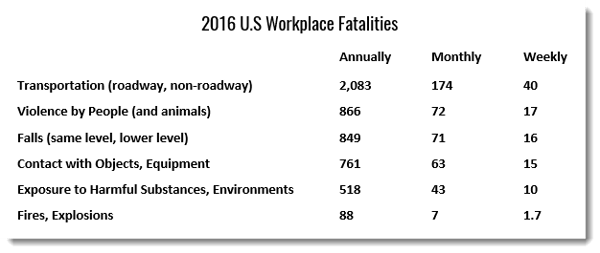There are thousands of workplace injuries each day in the U.S.--literally thousands. In 2014, The Bureau of Labor Statistics recorded almost 150,000 hand injuries that involved days away from work. That’s not all hand injuries; just those serious enough to result in lost time at work. As of 2018, there were a reported total of one million emergency room visits for work-related hand injuries.
With 130 million people working in the U.S. at over 8 million work sites, there are a wide variety of injuries. Some are relatively minor, but some require additional medical treatment with days away from work. Some injuries result in permanent disability while the most severe injury is a loss of life. In 2016, according to the U.S. Bureau of Labor Statistics, there were 5,190 workplace fatalities in the U.S. That’s 433 fatalities per month, 100 per week or just over 14 every day.
Here is a breakdown of workplace fatalities by type in 2016:

Incredibly, 14 fatalities per day for 2016 is a 63 percent reduction from the 38 fatalities per day back in 1970. Even though your organization may not experience fatalities, there is always an opportunity to improve safety. The changes that lower safety incidents in a company can also improve how the organization operates overall.
Prevention is the objective, but when an incident does occur, organizations should know how to wring out all the information. Workplace injuries need to be investigated to understand what can be done to prevent similar incidents. Some organizations think different approaches are needed for different incidents. A scientific approach that identifies cause and effect works the same for a safety incident as it does an equipment failure or any other problem. A simple, consistent approach to workplace investigations, regardless of size, will improve the way people communicate and solve problems.
There are three basic steps in the Cause Mapping® method of root cause analysis for investigating an injury. Each has a specific purpose.
1. Definition - What Is the Injury?
This is the definition of the injury or incident. It includes the type of injury, when it happened, under what conditions it occurred, where it happened, which system or equipment it involved, and what task the person was performing at the time of the incident. It should also include severity of the injury.
Even though the focus is on safety, any other goal that was affected should be captured to record the total impact to the organization. The frequency of occurrence should also be noted. Has this incident happened before or is this the first time? This is the definition of the problem, which includes the time and place. This information is essentially a checklist that should be collected for every incident. Notice, in this first step there are no Why questions.
2. Analysis - Why Did It Happen?
The analysis is where the issue is broken down into parts. The organization of these parts (causes and effects) provides a complete explanation of the incident. The cause-and-effect order answers all the how and why questions. This is where we build the Cause Map™ diagram. It starts as a simple 1-Why™ question that can expand into more detail. A 5-Why is a phase of the investigation that occurs after 4-Why and before 6-Why. There’s nothing special about fifth Why question, but it is a great way to start quickly. You’ll ask as many Why questions as you need to in order to thoroughly explain the issue.
The Cause Map diagram may go to a 10-, 15- or a 25-Why with parallel cause-and-effect relationships. Smaller injuries will have less detail, more severe incidents will have more. Just like a map of your town, the analysis zooms in and out as needed. Your town has all the streets just as an incident has all the causes. How many you choose to reveal is based on your needs--the magnitude of the issue (as defined in Step 1).
An incident can also be organized chronologically, which reveals the time sequence of the incident. The timeline helps to understand the details of an issue, but it does not explain why the incident occurred.
3. Solutions - What Action Should be Taken to Reduce Risk?
The purpose of this step is to identify action items. What specifically needs to be done to prevent this issue from occurring? The Cause Map diagram explains the issue and provides a framework for proposing ideas for solutions. This is an important part of problem solving that is widely misunderstood. Most organization believe that an investigation identifies the “root cause” or “root causes.” Those labels create some of the confusion about how an incident actually happens. All the causes had to happen for the incident to occur, which allows for a wide variety of solutions options that can be considered.
Problem solving must reflect the real world and get those who do the work (frontline) engaged in improving how the work is done and preventing issues. Most groups inadvertently make their safety investigations unnecessarily complicated. Stick to the basics.
Conclusion
Within a safety investigation, or any other problem, don’t get distracted by technique. Focus on principles first. Keep it simple, because your incidents may be complex. Review some of these root cause analysis examples on our website and let us know how we can help you with one of your safety incidents. We can review one of your issues for you to compare what you’re doing now with what a complete cause-and-effect analysis looks like. Contact our office for assistance.













